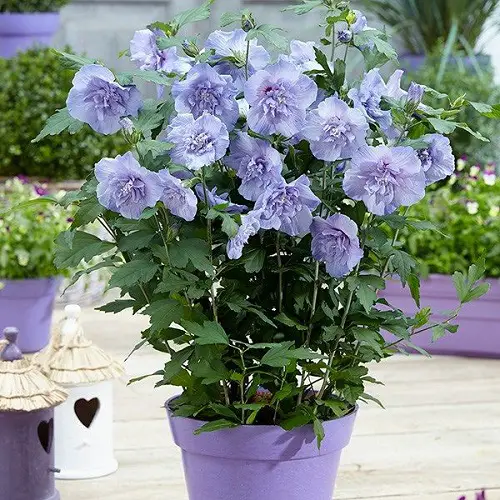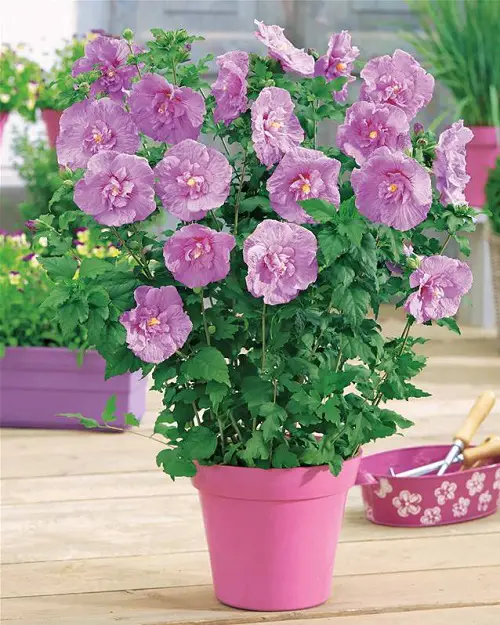Learn How to Grow Rose of Sharon in Pots and cultivate these big flowers for a colorful display on your porch or balcony!

If you want to add the beauty of big and colorful flowers in a small space, then learn How to Grow Rose of Sharon in Pots!
Have a look at the best Rose of Sharon varieties here
Rose of Sharon Information
The Rose of Sharon (Hibiscus syriacus) is a hardy deciduous shrub. It produces large, trumpet-shaped blooms in pink, purple, or white from summer to mid-fall over dark green, three-lobed foliage.
The name of this plant has an emblematic meaning in the Bible and is used to explain the charm of King Solomon’s lover in the book of Song of Solomon. Some perceive the Rose of Sharon as an emblem of Christ. Currently, this plant epitomizes the beauty, love, and healing of Christians and Jews.
It is the national flower of South Korea and showcases on many national emblems and banknotes. The Rose of Sharon is also known as tree hollyhock and Korean rose. This shrub only relates to one variety of hibiscus.
Growing Rose of Sharon in Pots

You can grow rose of Sharon in pots at any time of the year, but it will endure less stress when temperatures are not freezing. Begin with a compact-size variety and keep the plant where it gets full sun to partial shade.
You can use an 8-12 inches container and then gradually re-pot it into one size bigger pot depending on the plant’s growth.
Find out the Best Hibiscus Varieties here
Propagating Rose of Sharon
You can grow the plant from cuttings. The best time to do this is early to mid-summer. Plant the cutting in a pot filled with well-draining growing medium, water well, and keep it at a spot that gets bright and indirect light. It will form new growth in 2-4 weeks.
You can also grow it from seeds, but it can be time-consuming.
Requirements for Growing Rose of Sharon in Pots

Location
Choose a spot that gets a minimum of 4-5 hours of direct sunlight if you want the plant to grow plenty of flowers. It won’t mind being in partial shade, but the blooms won’t be as much.
Remember, the more sunlight it gets, the better it will be for the plant and the number of flowers.
Soil
The plant flowers well in rich and well-draining soil with slightly acidic soil with a pH between 5.5-7.5. Amending the growing medium with plenty of organic matter and coco peat at the planting time will boost the overall growth.
Water
Keeping the soil slightly moist will help increase the blossoms’ size. Water the plant when the topsoil feels a little dry to the touch. Also, avoid overwatering to keep the plant safe from root rot.
Discover the Best Hedge Plants here
Rose of Sharon Care

Fertilizer
Rose of Sharon is not a heavy feeder. Still, it will benefit from a monthly feed of a balanced liquid fertlizer, diluted to 1/2 of its strength. You can also fertilize the plant twice a month after diluting the feed to 1/4 of its dosage.
If you notice brown or yellow leaves, it’s a sign of overfeeding the plant.
Pests and Diseases
Japanese beetles, spider mites, aphids, scales, whiteflies, mealybugs, and thrips, can affect the plant. Wash the infected foliage with soapy water.
Plant failing to bloom is a sign of rot, and the absence of phosphorus is the reason for this. Bone meal or high phosphorus fertilizer can solve this issue.
Winter Care
Rose of Sharon plants is hardy in zones 5-11; if you live in zone 6 or below, protect the plant from the cold drafts. Do expose the plant to temperatures lower than 10 C (50F).
Also, mulch with 2-4 inches of shredded foliage or bark chips and cover the pot with bubble wrap or frost cloth.
Note: Do not move the plant indoors.


